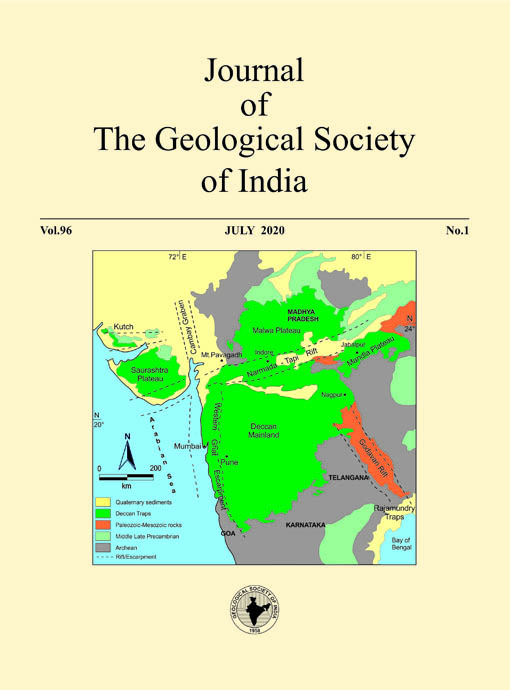Integrated Hydrogeological and Hydrochemical Studies in an Agri-horticulture Intensive Watershed at Narkhed, Nagpur, Maharashtra and Pandhurna, Chindwara, Madhya Pradesh - A Case Study from Central India
DOI:
https://doi.org/10.1007/s12594-020-1509-xKeywords:
No Keywords.Abstract
The present study is an attempt to investigate the impact of intensive agriculture and horticulture activities on the hydrogeological and hydrochemical regime in a watershed in Central India. The study area covers 137 km2 and the land use land cover (LULC) study shows that 39.72% area is agrihorticulture land, and 29.78% of the land is covered with other vegetation. Groundwater budgeting is aimed to estimate stage of groundwater development and to examine the contribution of different competing users (domestic, agriculture and industries) on groundwater usage. The groundwater budgeting results show that the stage of groundwater development is 100.26%, thus the study area falls under the over-exploited category as per GEC 2015 norms. The groundwater quality indicates the elevated concentration of nitrate (>45 mg/L) in 41% samples of pre-monsoon season and 80% samples in the post-monsoon season. The elevated concentration of nitrate in groundwater samples of the postmonsoon season indicates the contamination due to the non-point sources like excessive use of fertilizers in horti-agriculture. The sodium adsorption ratio (SAR) values indicate that groundwater is suitable for irrigation. However, physico-chemical water quality results show that 74% samples of pre-monsoon and 85% samples of the post-monsoon season are found unsuitable for drinking as compared to acceptable limits of drinking water specification BIS 10500:2012.
The study area needs intervention measures both on the supply side and demand side to bring the development stage and water quality to safer limits. Long term mitigation strategies for the revival of the natural streams should also be adopted to increase water availability in the study area. Precision agriculture, promotion of organic farming, minimization of water use, soil amendments for soil moisture retention and prevention of the runoff must be included in the management practices to improve the health of the watershed and for the long term sustainability.
Downloads
Metrics
Issue
Section
Downloads
Published
How to Cite
References
American Public Health Association (2015) Standard Methods for the examination of water and wastewater, 23rd ed., Washington DC.
Aksever, F., Davraz, A. and Karaguzel, R. (2015) Groundwater balance estimation and sustainability in the Sandiklii Basin (Afyonkarahisar/Turkey). Jour. Earth Syst. Sci., v.124(4), pp.783–798.
Calder, I. and Dye, P. (2001) Hydrological impacts of invasive alien Plants. Land Use and Water Resources Res., v.1, pp.8.1-8.12
Central Ground Water Board (2009) the Groundwater Water Resource Estimation Committee, Methodology; Ministry of Water Resource, River Development & Ganga Rejuvenation, Government of India, New Delhi.
Central Ground Water Board (2015) Aquifer Maps and Ground Water Management Plan, Katol and Narkhed Taluka, Nagpur District, Maharashtra (Part-I) 2015; Ministry of Water Resources, River Development and Ganga Rejuvenation Government of India, New Delhi. http://cgwb.gov.in/AQM/Maharashtra%20Report.html
Central Ground Water Board (2017) Ground Water Resource Estimation Committee (GEC-2015) Methodology; Ministry of Water Resource, River Development & Ganga Rejuvenation, Government of India, New Delhi.
Central Ground Water Board, South Eastern Coastal Region, Tamil Nadu (2017) Aquifer mapping and aquifer management, Chennai Aquifer System, Tamil Nadu; Ministry of Water Resources, River Development and Ganga Rejuvenation, Government of India, New Delhi.
Central Pollution Control Board (2007) Status of Groundwater Quality in India-Part-I 2007; Ministry of Environment, Forests & Climate change, Government of India, New Delhi.
Chamier, J., Schachtschneider, K., le Maitre, D.C., Ashton, P.J., and van Wilgen, B.W. (2012) Impacts of invasive alien plants on water quality, with particular emphasis on South Africa. Water SA, v.38(2) pp.345-356.
Department of Agriculture, Government of Maharashtra, India (2019) Dug Well and Bore well census data of the Narkhed block, Nagpur, Maharashtra, INDIA
Farmer Welfare and Agriculture Development Department, Government of Madhya Pradesh (2019) Dugwell and Borewell census data of Pandhurna block, Chindwara, Madhya Pradesh, India.
Fornés, J.M., Hera, A. de la, Llamas, M.R. and Martinez-Santos, P. (2007) Legal aspects of groundwater ownership in Spain. Water Internat., v.32(4), pp.286-674.
Gorgens, A.H.M. and van Wilgen, B.W. (2004) Invasive alien plants and water resources in South Africa: Current understanding, predictive ability and research challenges; South African Jour. Sci., v.100(1), pp.27-33.
Groundwater Surveys and Development Agency, Water Supply and Sanitation Department, Government of Maharashtra and Central Ground Water Board, Central Region, Nagpur, Ministry of Water Resource, River Development & Ganga Rejuvenation, Government of India, New Delhi 2014 The Dynamic Ground Water Resources of Maharashtra (2011-2012).
Gupta, S. (2011) Groundwater management in Alluvial area, Central Ground Water Board, New Delhi, http://cgwb.gov.in/documents/papers/incidpapers/Paper%2011-%20sushil%20gupta.pdf
IDFC Rural Development Network (2013) India Rural Development Report 2012|13
Indian Meteorological Department (2019) Data Accessed from: http://hydro.imd.gov.in/hydrometweb/(S(ygn3vt45cb0e1e551gjdznmi))/DistrictRaifall.aspx
Kulkarni, H., Shahb, M., Vijay, S. (2015) Shaping the contours of groundwater governance in India. Jour. Hydrol.: Regional Studies, v.4, Part A, pp.172-192.
Krishnan, M.S. (1982) Geology of India and Burma. 6th Edition; CBS Publishers & Distributors, pp.405-407.
Llamas, M.R., and Martínez-Santos, P. (2005) Intensive Groundwater Use: Silent Revolution and Potential Source of Social Conflicts. Water Resour. Plann. Manage. (Editorial), v.131(5), pp.337-342
Piper, A.M. (1953) A graphic procedure in the geochemical interpretation of water analysis; US Department of the Interior, Geological Survey, Water Resources Division, Groundwater Branch, Washington.
Pophare, A.M., Lamsoge, B.R., Katpatal, Y.B. and Nawale, V.P. (2014) Impact of over-exploitation on groundwater quality: A case study from WR-2 Watershed, India. Jour. Earth Syst. Sci., v.123(7) pp.541-1566.
Shah, T. (2009) India's Ground Water Irrigation Economy: The Challenge of Balancing Livelihoods and Environment; http://cgwb.gov.in/documents/papers/incidpapers/Paper%203-%20Tushaar%20Shah.pdf
Tiwari, V.M., Wahr, J., Swenson, S. (2009) Dwindling groundwater resources in northern India, from satellite gravity observations; Geophys. Res. Lett., v.36, L18401. DOI:10.1029/2009GL039401.

 Rafat Quamar
Rafat Quamar






